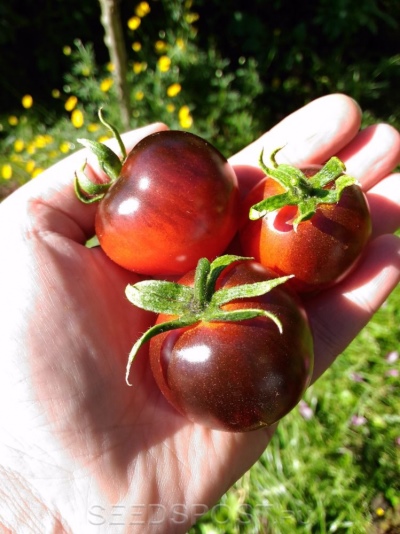
- Authors: Jim Myers, Oregon, USA
- Appeared when crossing: base - Indigo Rose
- Category: grade
- Growth type: indeterminate
- Appointment: fresh consumption
- Ripening period: early
- Ripening time, days: 95-100
- Growing conditions: for open ground, for closed ground
- Bush size: tall
- Bush height, cm: 160-180
You can dilute the beds with classic types of tomatoes by growing something exotic, but at the same time very tasty and incredibly useful for the human body. One of these is the early ripe tomato species Blueberry, which grows both in the garden and in the greenhouse.
Breeding history
Blueberry tomatoes are the result of painstaking work by American breeders led by D. Myers (Oregon). The cultivar Indigo Roses was used as a base. The nightshade crop grows both in greenhouses, and in greenhouses, and in unprotected soils. Recommended for growing tomatoes in all climatic zones of the country.
Description of the variety
Tomato Bilberry is a tall plant of an indeterminate type that can stretch to a height of 168-180 cm. The bushes have a strong central stem, moderate branching, high thickening with bright green leaves, a developed root system and simple inflorescences. 6-8 berries are tied in each fruit cluster.
During cultivation, do not forget about tying bushes to supports or trellises, as well as regularly removing stepchildren and thinning the foliage. Bushes are formed into one stem. Some gardeners recommend pinching the top, which helps to increase the mass of fruits in the brushes.
The purpose of exotic tomatoes is universal, so they can be eaten fresh, added to salads and many other dishes, as well as processed into sauces, dressings, and pastas. In addition, the smallest tomatoes are preserved whole.
The main qualities of the fruit
Blueberry is a large-fruited tomato weighing 150-180 grams. The exotic vegetable has a regular round shape and a smooth surface without the slightest ribbing. Ripe tomato has an unusual color - maroon with purple shoulders. In a state of technical maturity, the vegetable is green in color with purple shoulders. The skin of the berries is dense and glossy, not felt when eaten. Tomatoes are characterized by resistance to cracking, transportability and long shelf life.
A huge advantage of the variety is the composition of the vegetable pulp, which has a bactericidal effect, fills the body with useful antioxidants, strengthens the vascular walls, and protects the immune system from viruses and microbes.
Taste characteristics
The vegetable has excellent taste characteristics. The flesh of the berry is dense, fleshy and juicy. The taste is dominated by rich sweetness without the slightest acidity. The aroma of tomatoes is sweet and pleasant. The pulp with a small content of seeds has a maroon color.
Ripening and fruiting
The variety is early, therefore, from the moment of mass germination of seedlings to the first ripe fruits on the bushes, a little more than 3 months pass - 95-100 days. The culture has a prolonged fruiting period, which allows you to enjoy fresh and healthy tomatoes for a long time. In the greenhouse, the last berries can be removed from the bushes in the second half of October. The phase of active ripening of berries occurs at the end of July-August. The tasting of the first harvest begins in the second half of July.
Yield
If all the recommendations for cultivation are fulfilled, it collects 6-8 kg of tomatoes from 1 m2.When growing a plant in a garden, you can count on collecting 5-6 kg of tomatoes from 1 m2.
The timing of planting seedlings and planting in the ground
Sowing for seedlings is carried out after March 15. Fast germination will be ensured by the correct temperature regime in the room (22-24 degrees), a lot of light and a greenhouse effect, provided by covering the boxes with glass or polyethylene. Germination usually occurs on the 5-7th day. Diving is carried out at the stage of appearance of 2-3 true leaves near the bush. Fertilizers are applied a week after planting.
Tomatoes are transplanted at the age of 55-60 days. You can transfer seedlings to the greenhouse in the first half of May, and to the beds in the second.

Growing tomato seedlings is an extremely important process, because it largely depends on whether the gardener can harvest at all. All aspects must be taken into account, from seedbed preparation to planting in the ground.
Landing scheme
It is recommended to have 3-4 tomato bushes per 1 m2. Planting plants according to the 50x50 cm scheme will be correct.

Growing and caring
The soil for growing tomatoes should be loose and fertile. In addition, it must pass air and moisture well, and have a neutral alkaline balance. It is not recommended to plant tomatoes in an area where eggplants or potatoes were their predecessors. The best place will be where the cabbage or cucumbers used to grow.
Plant care is standard - watering, feeding, weeding and loosening the soil, garters and pinching, airing the greenhouse, protecting against insects and viruses.




A plant needs different micronutrients at each stage of growth. All fertilizers can be divided into two groups: mineral and organic. Folk remedies are often used: iodine, yeast, bird droppings, eggshells.
It is important to observe the rate and period of feeding. This also applies to folk remedies and organic fertilizers.
Disease and pest resistance
At the genetic level, the variety has a high immunity to many tomato diseases - late blight of fruits and leaves, apical and root rot, powdery mildew, fusarium wilting. Of the pests, only aphids are often annoyed by tomatoes, which will help to get rid of preventive treatments.


Resistant to adverse weather conditions
The tomato is endowed with high stress resistance, therefore it easily tolerates drought, heat, short shade and sharp temperature fluctuations.

























































































